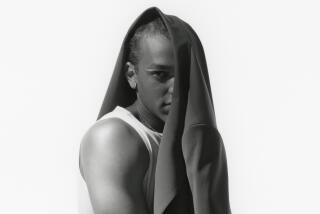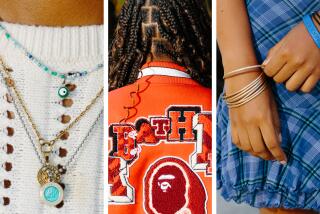For Reluctant Suitors : Men like what a coat and tie say about them. But they also yearn for a Huck Finn kind of freedom.
- Share via
Robert Fortunato is the kind of man who insists on looking sharp when he makes a sales call. A double-breasted jacket. Pleated and cuffed pants. He prefers neckties with geometric patterns.
“There’s a certain air of confidence when you have your best suit on,” he says.
But by five o’clock, the beauty has turned into a beast. The account manager’s white shirt is rumpled. His tailoring feels tight around the collar. Fortunato can’t wait to get home and change into shorts.
“Big, floppy shorts,” he says.
So it is that men have a love-hate relationship with their suits. What looks great on the pages of GQ magazine might not feel so great across the shoulders. Sartorial splendor lives a dual life in the workplace, where matters of style clash with old-fashioned chafing.
“If it’s a hot day, you end up with a sweat ball on your back,” Fortunato says. “You walk into a client’s office and you are trying to dry off.”
The suit, fashion experts say, is largely a creation of 20th-Century business. Its precursor, however, can be traced to the court of Louis XIV, where long coats, vests and tight breeches were de rigueur . Such garb was meant for lounging and gambling, not for rushing around office buildings or driving to a meeting in Orange County on an afternoon when the thermometer hits 110 degrees.
Yet the modern business world adapted the look, choosing to make it even more restrictive. A shirt collar was added. So was the loose cravat of the 19th Century, transformed into a snugly knotted tie.
This seemingly non-functional outfit was created to serve a definite function: it differentiates the office worker from the manual laborer.
“The suit sends a message of status,” says Mark Mallinger, a management professor at Pepperdine University. “It has nothing to do with someone’s knowledge or talent or ability. But it says, ‘Yes, I’ve attained this position. I’ve made it to a place where this is the acceptable garb.’ ”
This message can be delivered beyond the confines of the workplace. Men who wear uniforms or overalls in their jobs will dress up for a wedding. Sometimes Bruce Bingham, a vice president at Great Western Bank, keeps his suit on for dates or after-work dinners, depending on whom he wants to impress.
So the desire to send a message of prestige takes precedent while comfort squirms in the background. And men--wanting their cake and wanting to eat it, too--refuse to suffer this pageantry in silence.
“We have terms like ‘tight around the collar’ and ‘stuffed shirt,’ ” says Richard Martin, curator of the New Costume Institute at the Metropolitan Museum of Art in New York. “There’s a tremendous amount of vocabulary that reinforces this sense of stiff and uncomfortable.”
Not all the discomfort is physical. Suits can seem monotonous, a sea of gray and blue save for a narrow lapel here and a double-breasted there. That is why haberdashers sell outrageous ties, Martin says, all those colors and patterns worn as cries for individuality.
The psychological significance of the suit may reach even deeper into our psyches. Many men buy suits when they get married or get their first office job. The purchase marks a rite of passage, a step into manhood.
“It was something I looked forward to,” Bingham says, recalling his first work suit. “I was becoming a professional.”
Others aren’t so eager to put away childish things--in this case, blue jeans and T-shirts. Martin suggests that there is an aspect of every man that “wants to be Huckleberry Finn, barefoot along the banks of a river.”
Men often have their first coat-and-tie experience at a young age. Maybe their mother dressed them up for church. Maybe the only time they wore formal clothes was to attend a boring wedding or a tearful funeral. The stereotype of the little boy tugging at his scratchy wool suit is very real to some.
“I grew up in a dirt-poor coal town,” recalls Richard Glace, now a chemist for a dental products company in Santa Maria. “You put on your suit to go to church on Sunday morning, when you would much rather have been playing with your buddies in the railroad freight yard.
“Suits were always restrictive for me,” he says, “physically and, even more so, psychologically.”
Yet Glace insists that appearance is vital to dealing with clients and co-workers. Even if his company didn’t enforce a dress code, he would still wear a coat and tie.
This attitude is probably common, Mallinger says. The professor recalled a study in which men were asked about shaving. They complained that it was a hassle. Then researchers posed a hypothetical question: If there was a medication that stopped your whiskers from growing, that precluded the need for shaving, would you take it? The majority said no.
“The researchers concluded that shaving was a measure of manliness,” Mallinger said. “I wonder if the suit might have the same connection. It’s a pain in the butt, but it makes us feel confident.”
Not that such psychological and social trappings are immune to change. Formal fashion is looser than it was in the past. Comfortable fabrics like seersucker, once reserved for casual wear, are acceptable in the workplace. While bankers and stockbrokers still tend to dress conservatively--again a message: we’ll safely handle your money--workers in other types of businesses can wear unstructured styles or even T-shirts under their jackets.
Is the suit treading the evolutionary path of the dinosaur?
“We might end up with some modification,” Martin says. “But there will always be a need for formal dressing. I have a feeling the suit will never go away.”
Even if it does, Mallinger guesses that some other style will take its place. Some form of clothing that will deliver the same messages of class and caste, of power and responsibility.
Probably something less comfortable.
SUITING YOURSELF
* Experts tell how to pick a quality suit that fits. Pass on jackets and trousers in need of major alterations, they say. E2 And don’t forget color. Suit designers are big on gray this fall. E3







